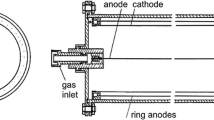Abstract
Resonance Ionization Mass Spectrometry (RIMS) has nowadays reached the status of a routine method for sensitive and selective ultratrace determination of long-lived radioactive isotopes in environmental, biomedical and technical samples. It provides high isobaric suppression, high to ultra-high isotopic selectivity and good overall efficiency. Experimental detection limits are as low as 106 atoms per sample and permit the fast and sensitive determination of ultratrace amounts of radiotoxic contaminations. Experimental arrangements for the detection of different radiotoxic isotopes, e.g. 236–244Pu, 89,90Sr and 99Tc in environmental samples are described, and the application of RIMS to the ultrarare long-lived radioisotope 41Ca for cosmochemical, radiodating and medical purposes are presented.
Similar content being viewed by others
Author information
Authors and Affiliations
Additional information
Received: 17 December 1998 / Revised: 11 February 1999/Accepted: 18 February 1999
Rights and permissions
About this article
Cite this article
Wendt, K., Blaum, K., Bushaw, B. et al. Recent developments in and applications of resonance ionization mass spectrometry. Fresenius J Anal Chem 364, 471–477 (1999). https://doi.org/10.1007/s002160051370
Issue Date:
DOI: https://doi.org/10.1007/s002160051370




